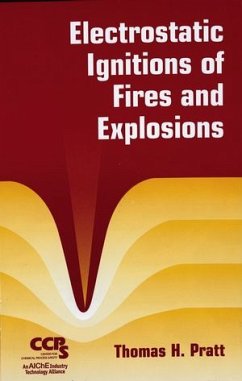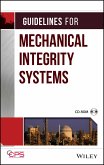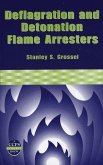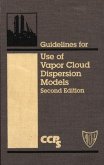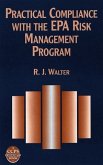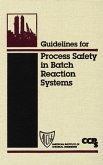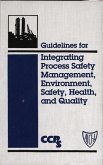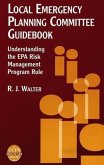Thomas H. Pratt
Electrostatic Ignitions of Fires and Explosions (eBook, PDF)
117,99 €
117,99 €
inkl. MwSt.
Sofort per Download lieferbar

0 °P sammeln
117,99 €
Als Download kaufen

117,99 €
inkl. MwSt.
Sofort per Download lieferbar

0 °P sammeln
Jetzt verschenken
Alle Infos zum eBook verschenken
117,99 €
inkl. MwSt.
Sofort per Download lieferbar
Alle Infos zum eBook verschenken

0 °P sammeln
Thomas H. Pratt
Electrostatic Ignitions of Fires and Explosions (eBook, PDF)
- Format: PDF
- Merkliste
- Auf die Merkliste
- Bewerten Bewerten
- Teilen
- Produkt teilen
- Produkterinnerung
- Produkterinnerung

Bitte loggen Sie sich zunächst in Ihr Kundenkonto ein oder registrieren Sie sich bei
bücher.de, um das eBook-Abo tolino select nutzen zu können.
Hier können Sie sich einloggen
Hier können Sie sich einloggen
Sie sind bereits eingeloggt. Klicken Sie auf 2. tolino select Abo, um fortzufahren.

Bitte loggen Sie sich zunächst in Ihr Kundenkonto ein oder registrieren Sie sich bei bücher.de, um das eBook-Abo tolino select nutzen zu können.
Tom Pratt, a long-time process safety practitioner and lecturer in electrostatic safety, wrote this book to educate industry in the basics of electrostatics. It offers a selected collection of information designed to give readers the tools they need to examine the hazard potential of common industrial processes. Among the topics addressed are separation and accumulation of charge, discharge, minimum ignition energies, discharge energies, electrification in industrial processes, design and operating criteria, measurements, quantification of electrostatic scenarios. A selection of case histories…mehr
- Geräte: PC
- ohne Kopierschutz
- eBook Hilfe
Andere Kunden interessierten sich auch für
![Guidelines for Mechanical Integrity Systems (eBook, PDF) Guidelines for Mechanical Integrity Systems (eBook, PDF)]() Ccps (Center For Chemical Process Safety)Guidelines for Mechanical Integrity Systems (eBook, PDF)163,99 €
Ccps (Center For Chemical Process Safety)Guidelines for Mechanical Integrity Systems (eBook, PDF)163,99 €![Deflagration and Detonation Flame Arresters (eBook, PDF) Deflagration and Detonation Flame Arresters (eBook, PDF)]() Stanley S. GrosselDeflagration and Detonation Flame Arresters (eBook, PDF)136,99 €
Stanley S. GrosselDeflagration and Detonation Flame Arresters (eBook, PDF)136,99 €![Guidelines for Use of Vapor Cloud Dispersion Models (eBook, PDF) Guidelines for Use of Vapor Cloud Dispersion Models (eBook, PDF)]() Ccps (Center For Chemical Process Safety)Guidelines for Use of Vapor Cloud Dispersion Models (eBook, PDF)193,99 €
Ccps (Center For Chemical Process Safety)Guidelines for Use of Vapor Cloud Dispersion Models (eBook, PDF)193,99 €![Practical Compliance with the EPA Risk Management Program (eBook, PDF) Practical Compliance with the EPA Risk Management Program (eBook, PDF)]() R. J. WalterPractical Compliance with the EPA Risk Management Program (eBook, PDF)80,99 €
R. J. WalterPractical Compliance with the EPA Risk Management Program (eBook, PDF)80,99 €![Guidelines for Process Safety in Batch Reaction Systems (eBook, PDF) Guidelines for Process Safety in Batch Reaction Systems (eBook, PDF)]() Ccps (Center For Chemical Process Safety)Guidelines for Process Safety in Batch Reaction Systems (eBook, PDF)144,99 €
Ccps (Center For Chemical Process Safety)Guidelines for Process Safety in Batch Reaction Systems (eBook, PDF)144,99 €![Guidelines for Integrating Process Safety Management, Environment, Safety, Health, and Quality (eBook, PDF) Guidelines for Integrating Process Safety Management, Environment, Safety, Health, and Quality (eBook, PDF)]() Ccps (Center For Chemical Process Safety)Guidelines for Integrating Process Safety Management, Environment, Safety, Health, and Quality (eBook, PDF)152,99 €
Ccps (Center For Chemical Process Safety)Guidelines for Integrating Process Safety Management, Environment, Safety, Health, and Quality (eBook, PDF)152,99 €![Local Emergency Planning Committee Guidebook (eBook, PDF) Local Emergency Planning Committee Guidebook (eBook, PDF)]() R. J. WalterLocal Emergency Planning Committee Guidebook (eBook, PDF)90,99 €
R. J. WalterLocal Emergency Planning Committee Guidebook (eBook, PDF)90,99 €-
-
-
Tom Pratt, a long-time process safety practitioner and lecturer in electrostatic safety, wrote this book to educate industry in the basics of electrostatics. It offers a selected collection of information designed to give readers the tools they need to examine the hazard potential of common industrial processes. Among the topics addressed are separation and accumulation of charge, discharge, minimum ignition energies, discharge energies, electrification in industrial processes, design and operating criteria, measurements, quantification of electrostatic scenarios. A selection of case histories helps illustrate sources of electrostatic ignition of combustibles, and strategies for preventing such incidents.
Dieser Download kann aus rechtlichen Gründen nur mit Rechnungsadresse in D ausgeliefert werden.
Produktdetails
- Produktdetails
- Verlag: John Wiley & Sons
- Erscheinungstermin: 7. September 2010
- Englisch
- ISBN-13: 9780470935149
- Artikelnr.: 38207110
- Verlag: John Wiley & Sons
- Erscheinungstermin: 7. September 2010
- Englisch
- ISBN-13: 9780470935149
- Artikelnr.: 38207110
- Herstellerkennzeichnung Die Herstellerinformationen sind derzeit nicht verfügbar.
Thomas H. Pratt is the author of Electrostatic Ignitions of Fires and Explosions, published by Wiley.
Chapter 1. Basic Concepts.
1.1. The Electrostatic Charge.
1.1.1. Electrons, Protons, and Ions.
1.1.2. Charge Distribution: Point, Space, and Surface Charges.
1.2. The Electric Field.
1.2.1. Mapping Electric Fields.
1.2.2. Dielectrics.
1.2.3. Dielectric Breakdown.
1.3. Ground Potential.
1.3.1. Grounding.
1.3.2. Bonding.
1.4. Requirements for a Fire or an Explosion.
1.4.1. Ignitable Mixture.
1.4.2. Separation.
1.4.3. Accumulation.
1.4.4. Discharge.
Chapter 2. Separation and Accumulation of Charge.
2.1. Mechanisms of Charge Generation.
2.2. Charge Alignment.
2.3. Contact and Frictional Charging.
2.3.1. Surface Charging.
2.3.2. Powder Charging.
2.4. Double Layer Charging.
2.5. Charging of Drops, Mists, and Aerosols.
2.6. Two Phase Flow.
2.7. Charge Separation at Phase Boundaries.
2.8. Charge Relaxation.
2.9. Host Material.
2.9.1. Bulk Conductivity.
2.9.2. Surface Conductivity.
2.9.3. Apparent Conductivity.
2.10. Separation vs. Relaxation.
2.10.1. constant Voltage Case.
2.10.2. Constant Amperage Case.
2.11. Induction.
3. Discharge.
3.1. Classification of Discharges.
3.2. Characteristics of Discharges.
3.2.1. Corona Discharge.
3.2.2. Brush Discharge.
3.2.3. Bulking Brush Discharge.
3.2.4. Propagating Brush Discharge.
3.2.5. Spark or Capacitor Discharge.
3.2.6. Lightning.
Chapter 4. Minimum Ignition Energies.
4.1. Testing of Materials.
4.2. Minimum Ignition Energy, MIE.
4.2.1. MIEs of Gasses and Vapors.
4.2.2. MIEs of Dusts.
4.2.3. MIEs of Hybrid Mixtures.
4.2.4. MIEs in Enriched Oxygen Atmospheres.
4.2.5. MIEs of Explosives.
Chapter 5. Discharge Energies.
5.1. Ignitions by Electrostatic Discharges.
5.2. Capacitive Discharges.
5.2.1. Human Sparks.
5.2.2. Clothing.
5.3. Brush Discharges.
5.3.1. Brush Discharges in Spaces.
5.3.2. Brush Discharges at Surfaces.
5.4. Bulking Brush Discharges.
5.5. Propagating Brush Discharges.
5.6. Corona Discharges.
Chapter 6. Electrification in Industrial Processes.
6.1. Charges in Liquids.
6.1.1. Streaming Currents.
6.1.2. Charge Relaxation in Liquids.
6.1.3. Liquid Conductivity.
6.1.4. Antistatic Additives.
6.1.5. Sedimentation.
6.2. Charges in Mists.
6.2.1. Washing.
6.2.2. Splash Loading.
6.2.3. Steaming.
6.2.4. Carbon Dioxide.
6.2.5. Charge Decay From Mists.
6.3. Charges in Powders.
6.3.1. Streaming Currents in Powders.
6.3.2. Charge Compaction in Powder Bulking.
6.3.3. Charge Relaxation in Powders.
6.4. Surface Charges.
6.4.1. Triboelectric Charging.
6.4.2. Humidity.
6.4.3. Conductive Cloth and Plastics.
6.4.4. Neutralizers.
6.5. Intense Electrification.
6.6. Phase Separation Charges.
7. Design and Operating Criteria.
7.1. Grounding and Bonding.
7.1.1. Insulation from Ground.
7.1.2. Spark Promoters.
7.2. In-Process Relaxation Times.
7.2.1. Quiescent Relaxations.
7.2.2. Relaxation Downstream of Filters.
7.3. Simultaneous Operations.
7.4. Sounding Pipes.
8. Measurements.
8.1. Multimeters.
8.2. Electrometers.
8.3. Electrostatic Voltmeters.
8.4. Fieldmeters.
8.5. Faraday Cage.
8.6. Radios.
9. Quantification of Electrostatic Scenarios.
9.1. Approximations.
9.1.1. Approximating Capacitance.
9.1.2. Approximating Resistance.
9.1.3. Approximating Charge.
9.2. Examples of Approximations.
9.2.1. Refueling an Automobile.
9.2.2. Filling a Gasoline Can.
9.2.3. Flexible Intermediate Bulk Container (FIBC).
9.2.4. The Minimum Capacitor for Incendive Discharge.
Chapter 10. Case Histories.
10.1. Vacuum truck Emptying a Sump.
10.2. Drawing Toluene into an Ungrounded Bucket.
10.3. Sampling while Loading a Railcar.
10.4. Vapor Ignition in a Roadtanker, I.
10.5. Vapor Ignition in a Roadtanker, II.
10.6. Instrumenting a Tank Containing Steam and a Flammable Atmosphere.
10.7. Conductive Liquid in a Plastic Carboy.
10.8. Chemical Hose with an Ungrounded Spiral.
10.9. Three incidents in a Pneumatic Transport System.
10.10. Offloading a Bulk Powder Truck.
10.11. Dumping Powder from a Drum with Metal chime.
10.12. Emptying a Powder from a Plastic Bag (Composite Case History).
10.13. Vapor Explosion in a Closed Tank.
10.14. Gas Well and Pipeline Blowouts.
Appendix A. Units.
Appendix B. Symbols Used in Equations.
Appendix C. Equations.
Appendix D. Atmospheric Electrostatics.
Appendix E. Electric Field Calculations.
Bibliography.
Concordance A, General.
Concordance B, Compounds and Materials.
1.1. The Electrostatic Charge.
1.1.1. Electrons, Protons, and Ions.
1.1.2. Charge Distribution: Point, Space, and Surface Charges.
1.2. The Electric Field.
1.2.1. Mapping Electric Fields.
1.2.2. Dielectrics.
1.2.3. Dielectric Breakdown.
1.3. Ground Potential.
1.3.1. Grounding.
1.3.2. Bonding.
1.4. Requirements for a Fire or an Explosion.
1.4.1. Ignitable Mixture.
1.4.2. Separation.
1.4.3. Accumulation.
1.4.4. Discharge.
Chapter 2. Separation and Accumulation of Charge.
2.1. Mechanisms of Charge Generation.
2.2. Charge Alignment.
2.3. Contact and Frictional Charging.
2.3.1. Surface Charging.
2.3.2. Powder Charging.
2.4. Double Layer Charging.
2.5. Charging of Drops, Mists, and Aerosols.
2.6. Two Phase Flow.
2.7. Charge Separation at Phase Boundaries.
2.8. Charge Relaxation.
2.9. Host Material.
2.9.1. Bulk Conductivity.
2.9.2. Surface Conductivity.
2.9.3. Apparent Conductivity.
2.10. Separation vs. Relaxation.
2.10.1. constant Voltage Case.
2.10.2. Constant Amperage Case.
2.11. Induction.
3. Discharge.
3.1. Classification of Discharges.
3.2. Characteristics of Discharges.
3.2.1. Corona Discharge.
3.2.2. Brush Discharge.
3.2.3. Bulking Brush Discharge.
3.2.4. Propagating Brush Discharge.
3.2.5. Spark or Capacitor Discharge.
3.2.6. Lightning.
Chapter 4. Minimum Ignition Energies.
4.1. Testing of Materials.
4.2. Minimum Ignition Energy, MIE.
4.2.1. MIEs of Gasses and Vapors.
4.2.2. MIEs of Dusts.
4.2.3. MIEs of Hybrid Mixtures.
4.2.4. MIEs in Enriched Oxygen Atmospheres.
4.2.5. MIEs of Explosives.
Chapter 5. Discharge Energies.
5.1. Ignitions by Electrostatic Discharges.
5.2. Capacitive Discharges.
5.2.1. Human Sparks.
5.2.2. Clothing.
5.3. Brush Discharges.
5.3.1. Brush Discharges in Spaces.
5.3.2. Brush Discharges at Surfaces.
5.4. Bulking Brush Discharges.
5.5. Propagating Brush Discharges.
5.6. Corona Discharges.
Chapter 6. Electrification in Industrial Processes.
6.1. Charges in Liquids.
6.1.1. Streaming Currents.
6.1.2. Charge Relaxation in Liquids.
6.1.3. Liquid Conductivity.
6.1.4. Antistatic Additives.
6.1.5. Sedimentation.
6.2. Charges in Mists.
6.2.1. Washing.
6.2.2. Splash Loading.
6.2.3. Steaming.
6.2.4. Carbon Dioxide.
6.2.5. Charge Decay From Mists.
6.3. Charges in Powders.
6.3.1. Streaming Currents in Powders.
6.3.2. Charge Compaction in Powder Bulking.
6.3.3. Charge Relaxation in Powders.
6.4. Surface Charges.
6.4.1. Triboelectric Charging.
6.4.2. Humidity.
6.4.3. Conductive Cloth and Plastics.
6.4.4. Neutralizers.
6.5. Intense Electrification.
6.6. Phase Separation Charges.
7. Design and Operating Criteria.
7.1. Grounding and Bonding.
7.1.1. Insulation from Ground.
7.1.2. Spark Promoters.
7.2. In-Process Relaxation Times.
7.2.1. Quiescent Relaxations.
7.2.2. Relaxation Downstream of Filters.
7.3. Simultaneous Operations.
7.4. Sounding Pipes.
8. Measurements.
8.1. Multimeters.
8.2. Electrometers.
8.3. Electrostatic Voltmeters.
8.4. Fieldmeters.
8.5. Faraday Cage.
8.6. Radios.
9. Quantification of Electrostatic Scenarios.
9.1. Approximations.
9.1.1. Approximating Capacitance.
9.1.2. Approximating Resistance.
9.1.3. Approximating Charge.
9.2. Examples of Approximations.
9.2.1. Refueling an Automobile.
9.2.2. Filling a Gasoline Can.
9.2.3. Flexible Intermediate Bulk Container (FIBC).
9.2.4. The Minimum Capacitor for Incendive Discharge.
Chapter 10. Case Histories.
10.1. Vacuum truck Emptying a Sump.
10.2. Drawing Toluene into an Ungrounded Bucket.
10.3. Sampling while Loading a Railcar.
10.4. Vapor Ignition in a Roadtanker, I.
10.5. Vapor Ignition in a Roadtanker, II.
10.6. Instrumenting a Tank Containing Steam and a Flammable Atmosphere.
10.7. Conductive Liquid in a Plastic Carboy.
10.8. Chemical Hose with an Ungrounded Spiral.
10.9. Three incidents in a Pneumatic Transport System.
10.10. Offloading a Bulk Powder Truck.
10.11. Dumping Powder from a Drum with Metal chime.
10.12. Emptying a Powder from a Plastic Bag (Composite Case History).
10.13. Vapor Explosion in a Closed Tank.
10.14. Gas Well and Pipeline Blowouts.
Appendix A. Units.
Appendix B. Symbols Used in Equations.
Appendix C. Equations.
Appendix D. Atmospheric Electrostatics.
Appendix E. Electric Field Calculations.
Bibliography.
Concordance A, General.
Concordance B, Compounds and Materials.
Chapter 1. Basic Concepts.
1.1. The Electrostatic Charge.
1.1.1. Electrons, Protons, and Ions.
1.1.2. Charge Distribution: Point, Space, and Surface Charges.
1.2. The Electric Field.
1.2.1. Mapping Electric Fields.
1.2.2. Dielectrics.
1.2.3. Dielectric Breakdown.
1.3. Ground Potential.
1.3.1. Grounding.
1.3.2. Bonding.
1.4. Requirements for a Fire or an Explosion.
1.4.1. Ignitable Mixture.
1.4.2. Separation.
1.4.3. Accumulation.
1.4.4. Discharge.
Chapter 2. Separation and Accumulation of Charge.
2.1. Mechanisms of Charge Generation.
2.2. Charge Alignment.
2.3. Contact and Frictional Charging.
2.3.1. Surface Charging.
2.3.2. Powder Charging.
2.4. Double Layer Charging.
2.5. Charging of Drops, Mists, and Aerosols.
2.6. Two Phase Flow.
2.7. Charge Separation at Phase Boundaries.
2.8. Charge Relaxation.
2.9. Host Material.
2.9.1. Bulk Conductivity.
2.9.2. Surface Conductivity.
2.9.3. Apparent Conductivity.
2.10. Separation vs. Relaxation.
2.10.1. constant Voltage Case.
2.10.2. Constant Amperage Case.
2.11. Induction.
3. Discharge.
3.1. Classification of Discharges.
3.2. Characteristics of Discharges.
3.2.1. Corona Discharge.
3.2.2. Brush Discharge.
3.2.3. Bulking Brush Discharge.
3.2.4. Propagating Brush Discharge.
3.2.5. Spark or Capacitor Discharge.
3.2.6. Lightning.
Chapter 4. Minimum Ignition Energies.
4.1. Testing of Materials.
4.2. Minimum Ignition Energy, MIE.
4.2.1. MIEs of Gasses and Vapors.
4.2.2. MIEs of Dusts.
4.2.3. MIEs of Hybrid Mixtures.
4.2.4. MIEs in Enriched Oxygen Atmospheres.
4.2.5. MIEs of Explosives.
Chapter 5. Discharge Energies.
5.1. Ignitions by Electrostatic Discharges.
5.2. Capacitive Discharges.
5.2.1. Human Sparks.
5.2.2. Clothing.
5.3. Brush Discharges.
5.3.1. Brush Discharges in Spaces.
5.3.2. Brush Discharges at Surfaces.
5.4. Bulking Brush Discharges.
5.5. Propagating Brush Discharges.
5.6. Corona Discharges.
Chapter 6. Electrification in Industrial Processes.
6.1. Charges in Liquids.
6.1.1. Streaming Currents.
6.1.2. Charge Relaxation in Liquids.
6.1.3. Liquid Conductivity.
6.1.4. Antistatic Additives.
6.1.5. Sedimentation.
6.2. Charges in Mists.
6.2.1. Washing.
6.2.2. Splash Loading.
6.2.3. Steaming.
6.2.4. Carbon Dioxide.
6.2.5. Charge Decay From Mists.
6.3. Charges in Powders.
6.3.1. Streaming Currents in Powders.
6.3.2. Charge Compaction in Powder Bulking.
6.3.3. Charge Relaxation in Powders.
6.4. Surface Charges.
6.4.1. Triboelectric Charging.
6.4.2. Humidity.
6.4.3. Conductive Cloth and Plastics.
6.4.4. Neutralizers.
6.5. Intense Electrification.
6.6. Phase Separation Charges.
7. Design and Operating Criteria.
7.1. Grounding and Bonding.
7.1.1. Insulation from Ground.
7.1.2. Spark Promoters.
7.2. In-Process Relaxation Times.
7.2.1. Quiescent Relaxations.
7.2.2. Relaxation Downstream of Filters.
7.3. Simultaneous Operations.
7.4. Sounding Pipes.
8. Measurements.
8.1. Multimeters.
8.2. Electrometers.
8.3. Electrostatic Voltmeters.
8.4. Fieldmeters.
8.5. Faraday Cage.
8.6. Radios.
9. Quantification of Electrostatic Scenarios.
9.1. Approximations.
9.1.1. Approximating Capacitance.
9.1.2. Approximating Resistance.
9.1.3. Approximating Charge.
9.2. Examples of Approximations.
9.2.1. Refueling an Automobile.
9.2.2. Filling a Gasoline Can.
9.2.3. Flexible Intermediate Bulk Container (FIBC).
9.2.4. The Minimum Capacitor for Incendive Discharge.
Chapter 10. Case Histories.
10.1. Vacuum truck Emptying a Sump.
10.2. Drawing Toluene into an Ungrounded Bucket.
10.3. Sampling while Loading a Railcar.
10.4. Vapor Ignition in a Roadtanker, I.
10.5. Vapor Ignition in a Roadtanker, II.
10.6. Instrumenting a Tank Containing Steam and a Flammable Atmosphere.
10.7. Conductive Liquid in a Plastic Carboy.
10.8. Chemical Hose with an Ungrounded Spiral.
10.9. Three incidents in a Pneumatic Transport System.
10.10. Offloading a Bulk Powder Truck.
10.11. Dumping Powder from a Drum with Metal chime.
10.12. Emptying a Powder from a Plastic Bag (Composite Case History).
10.13. Vapor Explosion in a Closed Tank.
10.14. Gas Well and Pipeline Blowouts.
Appendix A. Units.
Appendix B. Symbols Used in Equations.
Appendix C. Equations.
Appendix D. Atmospheric Electrostatics.
Appendix E. Electric Field Calculations.
Bibliography.
Concordance A, General.
Concordance B, Compounds and Materials.
1.1. The Electrostatic Charge.
1.1.1. Electrons, Protons, and Ions.
1.1.2. Charge Distribution: Point, Space, and Surface Charges.
1.2. The Electric Field.
1.2.1. Mapping Electric Fields.
1.2.2. Dielectrics.
1.2.3. Dielectric Breakdown.
1.3. Ground Potential.
1.3.1. Grounding.
1.3.2. Bonding.
1.4. Requirements for a Fire or an Explosion.
1.4.1. Ignitable Mixture.
1.4.2. Separation.
1.4.3. Accumulation.
1.4.4. Discharge.
Chapter 2. Separation and Accumulation of Charge.
2.1. Mechanisms of Charge Generation.
2.2. Charge Alignment.
2.3. Contact and Frictional Charging.
2.3.1. Surface Charging.
2.3.2. Powder Charging.
2.4. Double Layer Charging.
2.5. Charging of Drops, Mists, and Aerosols.
2.6. Two Phase Flow.
2.7. Charge Separation at Phase Boundaries.
2.8. Charge Relaxation.
2.9. Host Material.
2.9.1. Bulk Conductivity.
2.9.2. Surface Conductivity.
2.9.3. Apparent Conductivity.
2.10. Separation vs. Relaxation.
2.10.1. constant Voltage Case.
2.10.2. Constant Amperage Case.
2.11. Induction.
3. Discharge.
3.1. Classification of Discharges.
3.2. Characteristics of Discharges.
3.2.1. Corona Discharge.
3.2.2. Brush Discharge.
3.2.3. Bulking Brush Discharge.
3.2.4. Propagating Brush Discharge.
3.2.5. Spark or Capacitor Discharge.
3.2.6. Lightning.
Chapter 4. Minimum Ignition Energies.
4.1. Testing of Materials.
4.2. Minimum Ignition Energy, MIE.
4.2.1. MIEs of Gasses and Vapors.
4.2.2. MIEs of Dusts.
4.2.3. MIEs of Hybrid Mixtures.
4.2.4. MIEs in Enriched Oxygen Atmospheres.
4.2.5. MIEs of Explosives.
Chapter 5. Discharge Energies.
5.1. Ignitions by Electrostatic Discharges.
5.2. Capacitive Discharges.
5.2.1. Human Sparks.
5.2.2. Clothing.
5.3. Brush Discharges.
5.3.1. Brush Discharges in Spaces.
5.3.2. Brush Discharges at Surfaces.
5.4. Bulking Brush Discharges.
5.5. Propagating Brush Discharges.
5.6. Corona Discharges.
Chapter 6. Electrification in Industrial Processes.
6.1. Charges in Liquids.
6.1.1. Streaming Currents.
6.1.2. Charge Relaxation in Liquids.
6.1.3. Liquid Conductivity.
6.1.4. Antistatic Additives.
6.1.5. Sedimentation.
6.2. Charges in Mists.
6.2.1. Washing.
6.2.2. Splash Loading.
6.2.3. Steaming.
6.2.4. Carbon Dioxide.
6.2.5. Charge Decay From Mists.
6.3. Charges in Powders.
6.3.1. Streaming Currents in Powders.
6.3.2. Charge Compaction in Powder Bulking.
6.3.3. Charge Relaxation in Powders.
6.4. Surface Charges.
6.4.1. Triboelectric Charging.
6.4.2. Humidity.
6.4.3. Conductive Cloth and Plastics.
6.4.4. Neutralizers.
6.5. Intense Electrification.
6.6. Phase Separation Charges.
7. Design and Operating Criteria.
7.1. Grounding and Bonding.
7.1.1. Insulation from Ground.
7.1.2. Spark Promoters.
7.2. In-Process Relaxation Times.
7.2.1. Quiescent Relaxations.
7.2.2. Relaxation Downstream of Filters.
7.3. Simultaneous Operations.
7.4. Sounding Pipes.
8. Measurements.
8.1. Multimeters.
8.2. Electrometers.
8.3. Electrostatic Voltmeters.
8.4. Fieldmeters.
8.5. Faraday Cage.
8.6. Radios.
9. Quantification of Electrostatic Scenarios.
9.1. Approximations.
9.1.1. Approximating Capacitance.
9.1.2. Approximating Resistance.
9.1.3. Approximating Charge.
9.2. Examples of Approximations.
9.2.1. Refueling an Automobile.
9.2.2. Filling a Gasoline Can.
9.2.3. Flexible Intermediate Bulk Container (FIBC).
9.2.4. The Minimum Capacitor for Incendive Discharge.
Chapter 10. Case Histories.
10.1. Vacuum truck Emptying a Sump.
10.2. Drawing Toluene into an Ungrounded Bucket.
10.3. Sampling while Loading a Railcar.
10.4. Vapor Ignition in a Roadtanker, I.
10.5. Vapor Ignition in a Roadtanker, II.
10.6. Instrumenting a Tank Containing Steam and a Flammable Atmosphere.
10.7. Conductive Liquid in a Plastic Carboy.
10.8. Chemical Hose with an Ungrounded Spiral.
10.9. Three incidents in a Pneumatic Transport System.
10.10. Offloading a Bulk Powder Truck.
10.11. Dumping Powder from a Drum with Metal chime.
10.12. Emptying a Powder from a Plastic Bag (Composite Case History).
10.13. Vapor Explosion in a Closed Tank.
10.14. Gas Well and Pipeline Blowouts.
Appendix A. Units.
Appendix B. Symbols Used in Equations.
Appendix C. Equations.
Appendix D. Atmospheric Electrostatics.
Appendix E. Electric Field Calculations.
Bibliography.
Concordance A, General.
Concordance B, Compounds and Materials.
